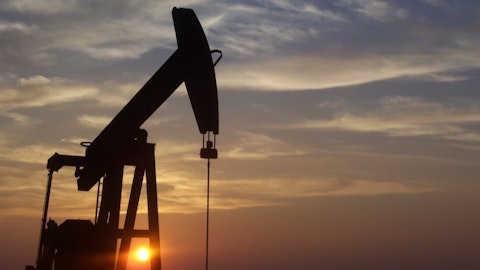And so we’ve spent an enormous amount of time gathering a library of data to understand how various different materials will respond inside of those wellbores. And so I think a major differentiator for us is it’s not one size fits all, it’s a very, very specialized tool designed in concert with the operator. So it’s a strong partnership. As I said, we’ve seen a huge amount of growth in the sales. I’m very excited to see more large, large operators become very interested in this. I think you’ll continue to see that as they are successful in lengthening out these laterals where it becomes very risky to drill out and complete past a certain depth. So we’re pretty excited about that. It’s a very — very few people that are competing inside of the dissolvable space in a legitimate way at scale.
So that is the other thing we feel we’ve mastered is the QA/QC and the manufacturing process even the way you deliver these plugs, the way you package them, it is all highly specialized because, of course, they’re dissolvable. So there’s only a few players we compete with that do this at scale. Of course, you’re always going to have your folks and garages saying we have a plug. But as far as who we see in the field, we’re — we think we’re one of the top three. And we are also, by the way, seeing a lot of traction in the international markets on the unconventional side, and that’s been very exciting for us. So the final piece I’ll just add here is, depending on what the SEC comes out with this Fall as far as those climate and emissions-related disclosures, this will be an even larger piece of the pie because, of course, you’re taking out so much combustion and therefore, CO2 emissions whenever you use dissolvables because you just don’t have diesel-based pumps or stick type diesel-based engine drilling out plugs.
So we think this is environmentally a much greener option. We certainly have quantified that for the market through independent studies through ERM. So we’re also excited about that. It was certainly part of the industrial logic and strategic rationale when we did the acquisition, I think we were just a little bit maybe early. And that — and now our operators are very, very focused on those emissions and strategies to reduce those emissions. And this is certainly a fabulous way to do that.
Timothy Moore: Great. Ann. Those are very helpful insights and the greener optionality just seems terrific for a catalyst to grow sales. So the rest of my questions were already answered today. So thanks, and have a nice weekend.
Ann Fox: Thank you, Tim. You too.
Guy Sirkes: Thank you.
Operator: Our next question is from John Daniel with Daniel Energy Partners. Please proceed with your question.
John Daniel: Good morning all.
Ann Fox: Hey, good morning.
Guy Sirkes: Good morning.
John Daniel: I’d like to think that the sort of consensus or conventional wisdom holds that activity phase moderates back half of the year, but then budgets reset and we go right back to work in the first half of ’24. Assuming that is the scenario, I guess the question is how are you handling labor right now, given the volatility of the work schedules with also a hope that we’re going to recover?
Ann Fox: This is a great question. And it’s — I don’t have an easy answer for you, John, because it’s something we actively debate. You’ve heard a lot of — a lot of folks in the sector say, we’re not going to take lower pricing. We’re focused on returns. We’re going to park our equipment, and that’s it. If you’re not going to give us a price we want, we’re done. Well, that’s very easy to say, except there is a human component called labor. And so the problem is that in order to hold those crews together, which, as you know, is critically important because the implicit communication and then the operational know-how developed inside those crews if you’re specializing them is extremely valuable. And so that collection of workforce is something that we have tried through this terrible rig count decline that we have tried to hold together.



